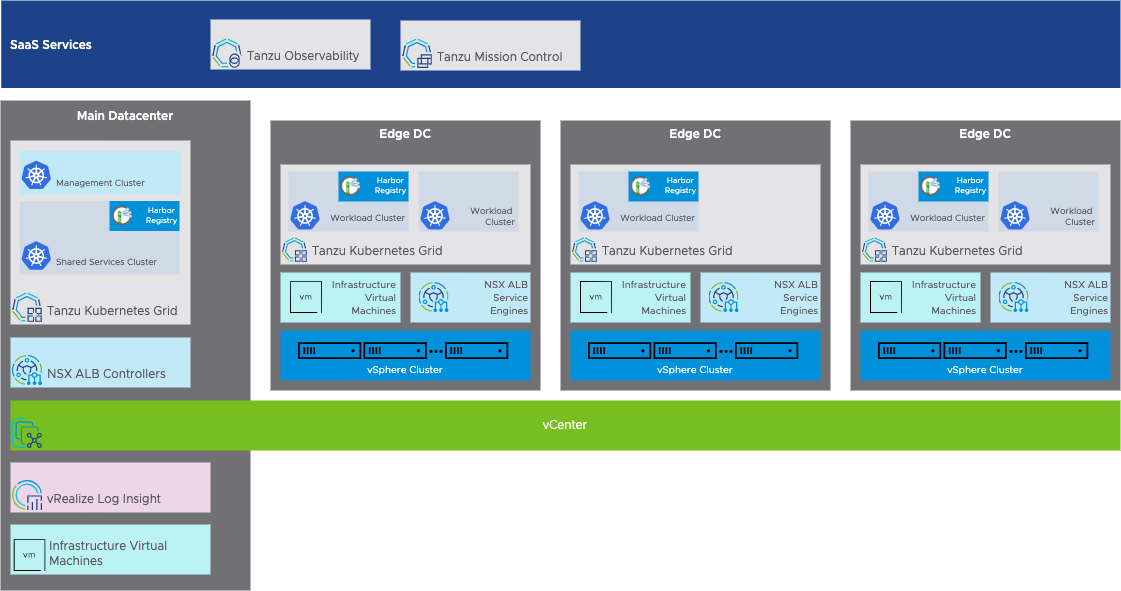VMware Edge Compute Stack (ECS) is a purpose-built platform that is designed to help organizations achieve their business goals by leveraging a range of powerful VMware technologies. This comprehensive platform consists of infrastructure and operation components, as well as enterprise-ready edge native application solutions. Additionally, it offers a variety of optional components for integrated networking, security, and monitoring, providing businesses with a single, centralized solution for their IT and OT needs.
By leveraging the ECS, organizations can enjoy improved efficiency, agility, and scalability, as well as reduced operational costs and complexity. With the ability to easily deploy, manage, and monitor their infrastructure and applications at the edge, the ECS empowers businesses to achieve their goals faster and more efficiently, while also delivering a more seamless and reliable experience for end-users.
Components
The current release of VMware ECS is built on the foundational VMware vSphere hyper-converged infrastructure (HCI) technologies and VMware Tanzu for workload management and Kubernetes operations.
vCenter - Central management for vSphere environment used to manage data center and Edge hosts.
vSphere ESXi – Hypervisor and a virtualization platform that abstracts computing, storage, and networking on server hosts.
Tanzu Kubernetes – Suite of Kubernetes-related products that helps users run and manage multiple Kubernetes clusters. Tanzu Kubernetes Grid, or TKG, is an upstream conformant Kubernetes runtime from VMware used to deploy and run Kubernetes clusters in public and private clouds.
Tanzu Mission Control - Centralized Kubernetes Cluster Management platform delivered as SaaS for consistently operating Kubernetes and modern applications across multiple teams and cloud infrastructures.
VMware Edge Cloud Orchestrator (VECO) telemetry – provides visibility into application traffic to or from the workloads hosted on ECS. VECO telemetry functionality is currently delivered by Edge Intelligence (EI), an AIOps solution leveraging big data and machine learning to accelerate problem resolution, improve visibility and insight, and proactive alerting.
Tanzu Kubernetes Grid on Enterprise Edge
Given the Edge Compute Stack aims to address large and distributed Edge deployments with a much smaller footprint than traditional Edge data centers, deploying Tanzu Kubernetes at the Edge requires changes to the Tanzu architecture for data centers due to limited compute, manageability of many sites, and limited connectivity.
The current architecture guide VMware Tanzu Edge Solution Architecture highlights three topologies for Tanzu Edge architecture – Hub and Spoke, Hybrid, and Data Center Fleet. The Data Center Fleet and Hybrid topologies will not be discussed in this guide as it’s uncommon for distributed Enterprise Edge sites to have enough computing and resources to run the full-stack infrastructure management plane (i.e., vCenter, NSX Advanced Load Balancers) and TKG Management Cluster. Our focus will be the Hub and Spoke topology where both the vCenter managing the Edge sites and the TKG Management Cluster will only reside in the data center. While the Edge sites with a limited footprint will only contain the VMs, containers, and TKG workload cluster for consumption by the apps.
In this Hub and Spoke topology, the NSX Advanced Load Balancer Service Engines are only recommended at the Edge if 3 or more nodes are in the cluster, and it has enough resources to deploy the Service Engines (minimum 1vCPU and 4GB RAM per Engine). For Service Type=LoadBalancer, Kube-vip is recommended for the Edge unless external load balancers with high performance are required.

Optional Components
The optional software solutions for the Edge Compute Stack are license add-ons to address use cases at the Edge for networking, storage, security, and observability. The solutions highlighted are offered in software and fully integrates with vSphere.
vSAN – Software-defined, an enterprise storage solution that is fully integrated with vSphere. vSAN aggregates data storage devices to create a single storage pool shared across all hosts in a cluster and works in conjunction with vSphere HA and DRS to provide compute and storage high availability.
VMware SD-WAN – SD-WAN is an overlay networking technology providing simplified networking, WAN high availability, and network security for campus and edge networks. It offers zero-touch provisioning, cloud security services, and end-to-end segmentation, and optimizes application performance from Edge sites through QoS and intelligent traffic steering. The VMware SD-WAN appliances can be integrated as external physical devices upstream from the vSphere cluster, or they can be deployed as highly available virtual appliances running on ESXi. For remote Edge locations, it can serve as the local DNS, NTP, and DHCP server, as well as the Edge firewall. SD-WAN plays a special role for Edges that have limited connectivity and/or use Internet connectivity for WAN as it can dynamically establish encrypted tunnels to the data center and enables network routing for the infrastructure and application components at the Edge.
Aria Operations – Operations management suite used for performance monitoring and analytics, troubleshooting, capacity, and workload management, and security and compliance in VMware virtual environments. It includes operations and observability for infrastructure, logs, networks, modern workloads, and Kubernetes.